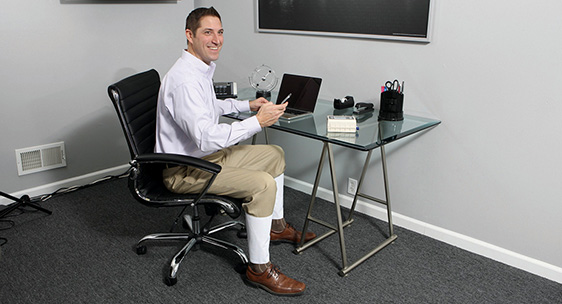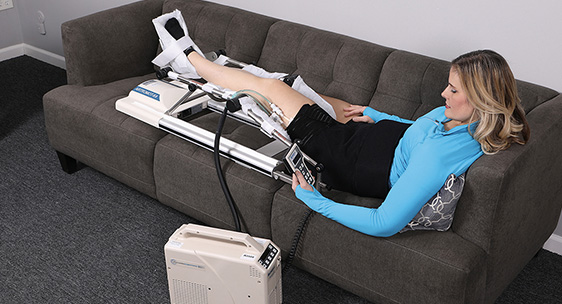HIP
Your hip aids in everyday activities like walking and bending – even rolling over in bed. So whether you’re gardening, working at a desk, or walking your dog, your hip is at work, keeping you mobile and well-aligned.
As one of the body’s largest joints, your hip is susceptible to osteoarthritis, rheumatoid and posttraumatic arthritis, and related injuries. Surgery is required when other forms of treatment – such as anti-inflammatory drugs, physical therapy or walking supports – have not fixed problems or reduced pain. While recovery after surgery can be long, painful and have complications, it doesn’t have to be. Lytle’s recovery equipment will help you return to normal functioning as soon as possible and with less pain.
Listed below are common hip procedures where Lytle Recover Now will allow you to shorten your recovery by preventing post-op blood clots, reducing pain and swelling, and providing safe motion.
HIP PROCEDURES
-
Labral Repair: Repairs the torn labrum that helps to stabilize your hip joint. Surgeons arthroscopically reconnect the cartilage ring to the acetabulum (socket) with sutures and anchors. Labrums can become torn through injury, anatomical deformities, or chronic wear.
-
Periacetabular Osteotomy (PAO): Repositions your hip socket at an angle so your joint is more stable, correcting hip dysplasia or a shallow hip socket to preserve the hip. These deformities are congenital or developmental and cause pain during activity or long periods of sitting.
-
Total Hip Replacement (THR): Replaces the femoral head (ball) and the acetabulum (socket). Total Hip Replacements are a solution for your advanced osteoarthritis pain. Needed when osteoarthritis wears away the smooth cartilage in your joint causing the bones to grind on each other.
-
Hip Scope: Removes foreign matter and dead tissue from the labrum and allows the surgeon to better assess your hip issue. Hip scopes may be required due to a specific injury or due to chronic issues.
Whatever procedure you’re undergoing, you are at risk of developing a blood clot, experiencing significant pain and swelling, or having scar tissue form around the hip that limits your range of motion.
To prevent these types of recovery complications and delays, Lytle Medical, in concert with your surgeon, provides you with a number of Rapid Recovery Services. These include a compression therapy device that prevents blood clotting that is common after surgery; a cold therapy device that minimizes the number of narcotic pain pills needed after surgery while simultaneously reducing swelling; and a motion therapy device that improves your range of motion.
- BLOOD CLOT PREVENTION
- RELIEF FROM PAIN
- RANGE OF MOTION
Preventing Blood Clots After Hip Surgery
Why would a blood clot form in my leg after hip surgery?
As you rest following surgery, the blood returns to your heart slower than usual and may form a clot. While everyone is vulnerable to blood clotting during post-surgical activity, your risk is increased with obesity, smoking, hormone replacement therapy, birth control medication, cancer, immobility, or a personal or family history of blood clotting – also called Deep Vein Thrombosis (DVT).
Why be concerned?
Developing a blood clot will significantly delay your recovery and is potentially life threatening. If the clot breaks free and travels to your lungs, it can restrict blood flow and the ability of the lungs to transfer oxygen to the blood. If you must to be treated for a blood clot while recovering from surgery, regaining your strength and function are put on hold while dealing with the more immediate crisis.
How to address it?
Blood clot prevention usually involves either a mechanical device that uses intermittent pneumatic compression to squeeze the calves to keep blood moving, or a pharmaceutical blood thinner that limits the blood’s ability to clot. These drugs are administered either orally or through self-injection and carry significant risks associated with stomach ulcers and uncontrolled internal bleeding.
Recover Now with the Rapid Recovery Preventer

Lytle’s Rapid Recovery Preventer is a mechanical solution to blood clot prevention. The Preventer intermittently squeezes your calves to force blood to flow using a wrap placed around the lower leg that supplies a gentle and intermittent compression of the calf muscle. The Preventer pushes blood up and out of your leg every 45 seconds or so even when you’re sitting or sleeping. Between compressions, the Preventer partially deflates to allow fresh blood to take the place of the pooled/stagnant blood.
IN ADDITION TO INCREASING BLOOD FLOW TO PREVENT CLOTS, THE PREVENTER HAS OTHER BENEFITS:
- Reduces swelling and edema
- Allows for a portable safe and convenient recovery
- Improves lymphatic drainage
- Improves soft tissue healing
- Provides consistent therapy
- Provides the optimal dosage of therapy – correct hours/repetitions per day
How to get the Rapid Recovery Preventer
To prevent a catastrophic delay in your recovery or serious complications from a blood clot,
make sure you use the Preventer. Follow these easy steps now:
-
1
Download and print the
DVT Preventer order form,
then take the risk assessment quiz. -
2
Review the sections on Reducing Pain
and Swelling and Providing Safe Motion
to see if these Rapid Recovery services
also should be included with your order. -
3
Have your surgeon or primary care physician
sign the order form and return it to our
company via email at patientcare@golytle.com
or fax it to 248-626-3113. -
4
Answer a call from our Rapid Recovery specialist
who will initiate your Rapid Recovery Services.
Reducing Pain and Swelling After Hip Surgery
Why does surgical trauma cause pain and swelling?
All orthopedic surgeries of the hip involve at least one invasive action that results in pain and swelling. It’s a result of an overabundance of restorative fluid accumulating in the joint that your body then needs to remove. The excess fluid causes you increased pain and swells the hip area making it difficult to move.
Why be concerned?
Normally the pain and swelling caused by your body’s response to an invasive event is a good thing. It discourages you from bearing weight or bending your hip. However, in the case of surgical recovery, the swelling and pain associated with a traumatic event will delay recovery.
How to address it?
Cryotherapy and compression therapy are two common ways to reduce the pain and swelling after surgery. Cryo and compression help avoid any delay or detriment to your hip healing. Applying intermittent cryotherapy to the repaired hip lowers pain levels and constricts blood vessels that temporarily reduce blood flow to the area allowing the blood to remove injured cells and return oxygenated and replenished blood with healing nutrients. Compression also reduces swelling by slowly squeezing the fluid out of the area. The dynamic and sequential compression found in the Reliever helps gently massage the swelling out of the area.
Recover Now with the Rapid Recovery Reliever

The best combination for accelerating your post-surgical recovery is to combine cryotherapy and compression therapy to reduce pain by deadening the nerve endings, limiting swelling and allowing for earlier motion. Lytle’s Rapid Recovery Cold Compression Reliever does both. The Reliever turns the cryotherapy cycles on and off while compression stays dynamic, a design that makes it an extremely safe device as there is little risk of tissue damage due to too tight compression.
IN ADDITION TO DECREASING PAIN AND SWELLING, THE RELIEVER HAS OTHER BENEFITS
- Lowers narcotic use
- Improves soft tissue healing
- Improves fluid and lymphedema drainage
- Increases blood flow
- Operates easily
- Reduces stress on the repair and hip joint
- Allows for safe, convenient recovery
- Provides the optimal dosage of therapy – correct hours per day
- Reduces your out-of-pocket cost
How to get the Rapid Recovery Reliever
To reduce pain a speed up the recovery process, make sure you use the Reliever. Follow these easy steps now:
-
1
Download and print the
Rapid Recovery Cold Compression order form</a -
2
Review the sections on Blood Clot Prevention
and Providing Safe Motion to see if these
Rapid Recovery services should also be included
with your order. -
3
Have your surgeon or primary care physician sign
the order form and return it to our company via
email at patientcare@golytle.com
or fax it to 248-626-3113. -
4
Answer a call from our Rapid Recovery Specialist
who will initiate your Rapid Recovery Services.
Regaining Complete Motion After Hip Surgery
Why does scar tissue form after hip surgery?
After surgery, the cells in your restorative fluid heal your connective tissue. The orientation of
the repaired connective tissue is influenced by movement. If the tissue is immobilized it can form in a random pattern. Sometimes this random pattern leads to scar tissue.
Why be concerned?
Scar tissue can cause significant delays in healing and in some instances require a second surgery to regain the motion in your hip. Scar tissue can cause pain, stiffness and trouble moving your hip and legs.
How to address it?
Moving your hip after surgery is critical to a healthy recovery because the movement helps you
form strong tissue – not scar tissue. The way to properly move your hip is by a therapy called passive motion. A physical therapist (PT) can provide this motion at his/her office, or a Continuous Passive Motion device can be used at home to slowly move your hip in a safe, controlled manner. A continuous passive motion (CPM) device is a great way to provide the movement needed for a successful recovery.
Recover Now with the Rapid Recovery Mover

Lytle’s Rapid Recovery Mover is a safe and convenient way to provide passive motion therapy to maximize the formation of strong tissue and accelerate the speed of your recovery. The microprocessor-controlled device automatically sets the speed and the range at which your hip is moved according to what your surgeon has prescribed. This safe and controlled motion does not over stress the repaired tissues and provides PT-quality therapy in your own home.
IN ADDITION TO IMPROVING MOTION, THE MOVER HAS OTHER BENEFITS:
- Allows for safe increases in motion as you heal
- Improves soft tissue healing
- Reduces swelling and edema
- Speeds up recovery
- Helps muscle stay passive (not fire while fighting the urge to contract and guard the joint)
- Provides consistent therapy – not dependent on availability of physical therapist
- Allows for safe, convenient recovery – less driving to/from physical therapy
- Provides the optimal dosage of therapy – correct number of hours and repetitions per day
- Reduces your out-of-pocket cost
How to get the Rapid Recovery Mover
To get your range of motion back after surgery,make sure you use the Mover. Follow these easy steps now:
-
1
Download and print the
Rapid Recovery Mover order form. -
2
Review the sections on Blood Clot Prevention
and Reducing Pain and Swelling to see if these
Rapid Recovery services should also be included
with your order. -
3
Have your surgeon or primary care physician sign
the order form and return it to our company
via email at patientcare@golytle.com
or fax it to 248-626-3113. -
4
Answer a call from our Rapid Recovery Specialist
who will initiate your Rapid Recovery Services.



